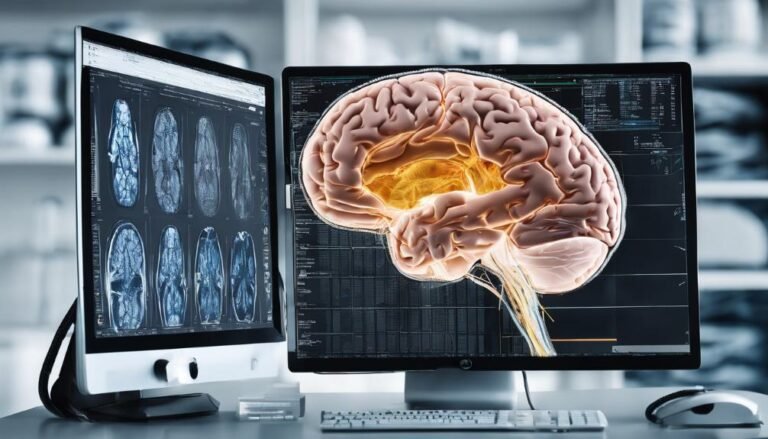AI for Disease Modeling
Did you know that AI has been shown to predict disease outbreaks up to six months in advance with an impressive accuracy rate of over 90%? This advanced technology is reshaping the way we approach disease modeling and management, offering a glimpse into a future where proactive measures could potentially mitigate the impact of health crises before they escalate. The integration of AI in disease modeling holds promise for revolutionizing healthcare practices, but what are the challenges and ethical considerations that accompany this groundbreaking innovation? Explore the intricate web of possibilities and complexities that AI for disease modeling presents in the domain of public health.
Key Takeaways
- AI enhances disease surveillance with real-time analysis and tracking.
- Big data analysis identifies trends, risk factors, and disease progression.
- Machine learning predicts disease patterns, aiding treatment optimization.
- AI supports epidemiological studies for efficient outbreak prediction and containment.
- Real-time outbreak detection through AI enables rapid response and targeted interventions.
The Role of AI in Disease Surveillance
AI plays a significant role in disease surveillance by enabling real-time analysis of large volumes of data to detect outbreaks and monitor trends efficiently. AI surveillance systems have revolutionized disease tracking by leveraging sophisticated algorithms to sift through vast amounts of information swiftly and accurately. Through AI applications, healthcare professionals can now access real-time updates on disease prevalence, transmission patterns, and potential hotspots, allowing for proactive interventions and resource allocation.
One of the key strengths of AI in disease surveillance is its ability to enhance data accuracy. By automating the process of data collection, AI minimizes human error and guarantees that information is consistently and reliably recorded. This high level of data accuracy is pivotal for tracking the spread of diseases effectively and making informed decisions to protect public health.
With AI at the forefront of disease surveillance efforts, the healthcare industry is better equipped to respond promptly to emerging health threats and safeguard communities worldwide.
Leveraging Big Data for Disease Analysis
Efficient disease analysis in the modern healthcare landscape heavily relies on the strategic use of big data to extract valuable insights and trends for informed decision-making. Data analysis plays a pivotal role in uncovering patterns, correlations, and anomalies within vast datasets to enhance disease understanding. By leveraging advanced data analysis techniques, healthcare professionals can identify risk factors, track disease progression, and evaluate the effectiveness of interventions.
Technology integration is essential for handling the sheer volume and complexity of healthcare data generated daily. Integrating cutting-edge technologies like artificial intelligence and machine learning algorithms allows for real-time data processing and analysis, enabling quicker identification of disease trends and patterns. These technologies also facilitate the integration of diverse data sources, such as electronic health records, genomics data, and environmental factors, providing a holistic view of disease dynamics.
Predictive Modeling With Machine Learning
Utilizing machine learning techniques enables the creation of predictive models that can forecast disease trends based on complex data patterns. In the domain of disease progression, machine learning plays an essential role in predicting how a disease may evolve over time. By analyzing vast amounts of patient data, machine learning algorithms can identify subtle patterns that may indicate the progression of a disease, helping healthcare professionals intervene proactively.
Furthermore, machine learning contributes greatly to treatment optimization by analyzing various factors such as genetic makeup, lifestyle choices, and environmental influences to personalize treatment plans. Predictive analytics, a key component of machine learning, allows for the prediction of how patients may respond to different treatments, aiding in the selection of the most effective therapeutic interventions.
Enhancing Epidemiological Studies With AI
Enhancing epidemiological studies involves leveraging advanced algorithms to analyze large-scale population data for detecting patterns and trends related to disease spread and transmission.
AI-driven forecasting plays an important role in predicting the future trajectory of diseases by processing vast amounts of data efficiently. These forecasts help public health officials make informed decisions regarding resource allocation, intervention strategies, and policy planning.
AI-enhanced surveillance further strengthens epidemiological studies by enabling real-time monitoring of disease outbreaks. By continuously analyzing incoming data from various sources such as electronic health records, social media, and environmental sensors, AI can swiftly detect anomalies and patterns indicative of potential outbreaks.
This proactive approach allows for early intervention and containment measures to be implemented promptly, minimizing the impact of diseases on populations.
Real-time Outbreak Detection Using AI
You can leverage AI systems for rapid outbreak detection, enabling real-time monitoring of disease patterns.
These AI monitoring systems can analyze vast amounts of data swiftly, providing early warning alerts for potential outbreaks.
Rapid Outbreak Detection
AI-driven rapid outbreak detection systems have revolutionized disease surveillance by enabling real-time monitoring and early identification of potential health threats. Through advanced data visualization techniques and geographic mapping, these systems can quickly pinpoint areas experiencing spikes in disease cases.
Network analysis plays an essential role in understanding the spread of infections, allowing for the prediction of outbreak patterns and hotspots.
Furthermore, the integration of social media tracking enhances the capabilities of these systems by monitoring real-time discussions and trends related to symptoms, outbreaks, and healthcare-seeking behavior. By analyzing social media data, AI can detect signals of potential outbreaks before they're reported through official channels.
This proactive approach enables public health officials to respond swiftly and implement targeted interventions to contain the spread of diseases.
AI Monitoring Systems
Utilizing advanced algorithms and machine learning techniques, real-time outbreak detection systems powered by artificial intelligence revolutionize disease monitoring and surveillance. AI monitoring systems leverage predictive analytics to identify patterns and anomalies in vast amounts of data, enabling early intervention and response to potential outbreaks. These systems continuously analyze diverse data sources such as social media, healthcare records, and environmental factors to detect emerging threats promptly.
By monitoring real-time data streams, AI systems can detect subtle changes that may indicate the onset of a disease outbreak. Through the use of predictive analytics, these systems can forecast the spread of diseases, helping authorities allocate resources effectively and implement targeted interventions.
The ability of AI monitoring systems to provide up-to-the-minute information allows for rapid decision-making and proactive measures to contain outbreaks before they escalate.
Early Warning Alerts
Through real-time analysis of diverse data sources, early warning alerts powered by artificial intelligence enable rapid detection of potential disease outbreaks. These alerts leverage advanced algorithms to guarantee high accuracy in identifying patterns indicative of emerging health threats. Algorithm accuracy is vital in providing timely alerts to public health authorities, allowing for swift response planning and containment efforts.
Moreover, alert customization plays a critical role in tailoring notifications to specific regions or demographics that may be more susceptible to certain diseases. This customization enhances the relevance and effectiveness of early warning systems, enabling targeted interventions and resource allocations.
Data interpretation is a key component of early warning alerts, as AI algorithms sift through vast amounts of information from various sources to identify potential outbreaks. By analyzing this data in real-time, AI can offer actionable insights to support public health decision-making and response strategies.
Precision Medicine and AI Integration
By integrating precision medicine principles with AI technologies, healthcare researchers are gaining unprecedented insights into individualized treatment strategies for complex diseases. The synergy between personalized treatments and algorithm optimization allows for a more tailored approach to patient care.
AI plays a pivotal role in interpreting vast amounts of patient data, enabling healthcare providers to identify patterns and predict outcomes with greater accuracy.
Through the integration of AI in precision medicine, researchers can optimize algorithms to analyze genetic, environmental, and lifestyle factors that influence disease development and progression. This integration not only enhances the understanding of disease mechanisms but also facilitates the identification of best treatment options for each patient.
AI-Driven Public Health Interventions
The application of AI in public health interventions revolutionizes the approach to population-level disease prevention and management by harnessing data-driven insights and predictive analytics. AI-driven vaccination strategies play an essential role in optimizing public health response using AI.
By analyzing vast amounts of data, AI can identify high-risk populations, predict disease spread patterns, and recommend effective vaccination strategies to contain outbreaks. Disease spread simulation through AI-powered interventions allows public health officials to model various scenarios, evaluate potential outcomes, and make informed decisions to mitigate the spread of diseases efficiently.
These AI-driven interventions enable proactive measures to be taken, such as targeted vaccination campaigns or resource allocation based on predicted disease hotspots. By leveraging AI in public health interventions, decision-makers can enhance the effectiveness of disease prevention strategies and better protect the health of communities on a larger scale.
Ethical Considerations in AI Disease Modeling
When considering ethical aspects of AI disease modeling, you must prioritize privacy to guarantee sensitive health data is protected.
Additionally, being aware of biases inherent in data collection and algorithm development is vital to prevent perpetuating disparities in healthcare outcomes.
Ensuring robust data security measures are in place is essential to maintain trust in AI disease modeling systems.
Privacy in AI
Privacy considerations play a significant role in the ethical implementation of AI for disease modeling, guaranteeing the protection of individuals' sensitive data and maintaining trust in the technology.
Data protection is crucial in AI applications to prevent unauthorized access or misuse of personal information. Algorithm transparency is essential for understanding how AI systems make decisions based on data, fostering accountability and facilitating trust between users and the technology.
By implementing robust data protection measures such as encryption, secure data storage, and strict access controls, the risk of privacy breaches can be minimized. Transparent algorithms allow researchers and healthcare professionals to validate the accuracy and fairness of AI disease models, enhancing their reliability and effectiveness.
Ethical guidelines that prioritize privacy and transparency in AI development are indispensable to uphold the integrity of disease modeling processes and safeguard individuals' private information. Embracing these principles not only ensures ethical practices but also promotes public confidence in the use of AI for disease management and prevention.
Bias Awareness
Maintaining bias awareness in AI disease modeling is vital for preserving the integrity and fairness of the predictive models. Bias identification is essential in recognizing and rectifying any prejudices that may exist within the algorithms. Algorithm fairness must be continuously monitored to prevent any skewed outcomes that could disproportionately impact certain demographic groups.
Diversity awareness plays a significant role in mitigating bias within AI disease modeling. It's essential to guarantee that the data used for training these models is representative of the diverse populations that will be affected by the predictions.
Data Security
Maintaining data security in AI disease modeling is a critical ethical consideration that requires stringent safeguards to protect sensitive information and uphold patient confidentiality. Cybersecurity measures play a pivotal role in guaranteeing the integrity and confidentiality of healthcare data utilized in disease modeling.
Robust encryption techniques are imperative to safeguarding patient information from unauthorized access or breaches. Implementing strong authentication mechanisms and access controls helps prevent data tampering and ensures that only authorized personnel can access sensitive datasets.
Data encryption techniques such as Advanced Encryption Standard (AES) and Secure Sockets Layer (SSL) are commonly employed to secure data transmission and storage in AI disease modeling applications. Additionally, utilizing secure communication protocols and regularly updating security protocols are crucial to mitigating cybersecurity risks associated with disease modeling AI systems.
Future Implications of AI in Healthcare
In the rapidly evolving landscape of healthcare, the future implications of AI are poised to revolutionize disease modeling and treatment strategies. The integration of AI technologies holds great promise in enhancing healthcare efficiency through quicker and more accurate disease diagnosis, personalized treatment plans, and improved patient outcomes.
However, as AI continues to advance, ethical considerations, such as AI ethics and patient privacy, must be carefully addressed to guarantee the responsible and secure implementation of these technologies in healthcare settings.
AI's ability to analyze vast amounts of data at speeds surpassing human capabilities can notably enhance disease prediction and prevention. By leveraging AI algorithms, healthcare professionals can make more informed decisions, leading to better patient care and resource allocation.
Additionally, AI's precision and accuracy in interpreting complex medical data can enable early disease detection and intervention, ultimately improving patient outcomes and reducing healthcare costs. As the field of AI in healthcare progresses, it's essential to prioritize patient privacy and maintain high standards of AI accuracy to maximize the potential benefits of these technologies while upholding ethical standards and data security.
Conclusion
As you reflect on the transformative power of AI in disease modeling, envision a future where data-driven insights pave the way for proactive healthcare interventions.
Like a beacon of light in a sea of uncertainty, AI illuminates the path towards improved disease surveillance, personalized treatment strategies, and enhanced public health outcomes.
Embrace the potential of AI to revolutionize healthcare, forging a path towards a brighter, healthier future for all.







